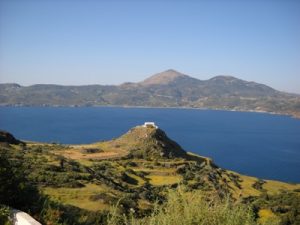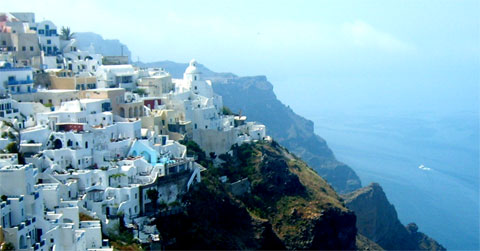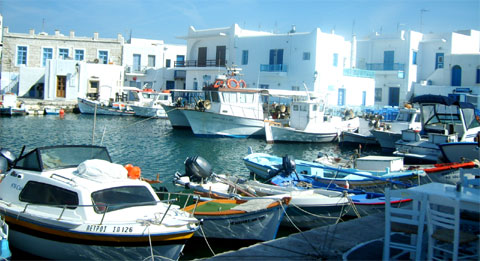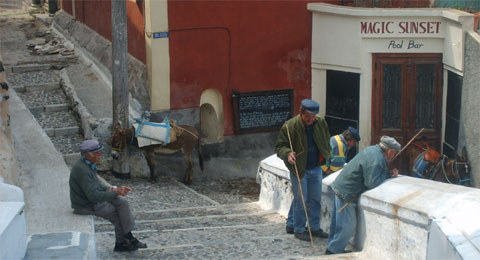The Cycladic islands can be reached directly by ferry from Athens, Heraklion (Crete) and many other eastern Greek islands. There are one or more ferries to all of the larger Cyclades every day (more in summer than in winter). The islands of Mykonos, Paros, Naxos, Ios and Santorini are particularly frequently visited.
Islands that are off this route are less frequently served by ferries. However, you can change. There are also many smaller ferries between the islands. From Iraklio (Crete) there are 1-2 ferries a day in summer that connect Crete with the main Cyclades islands. There is a campsite on almost all islands. Simple private rooms are available everywhere. Rooms are often loudly advertised at the harbor. The Cyclades are also becoming increasingly popular for sailing holidays. The Cyclades are ideal for a sailing holiday because the sea is quite calm in summer and storms are rare. There are many agencies and private individuals who offer sailing trips at relatively reasonable prices.
Film: Good ARD documentary about the Cyclades
My favorite hotels in the Great Cyclades |
|
| – Simple rooms, usually with their own toilet/shower – Click on the hotel name to get more information and prices (online booking is possible) – When selecting accommodation in the Cyclades, particular attention was paid to price. Positive feedback from holidaymakers also plays a major role. |
|
|
Location |
hotel name |
| Santorini | Onar Perissa |
| Paros | Casa Di Roma |
| Ios | Pension Galini |
| Naxos | Infinity Appartments |
| Mykonos | Hotel Milena |
| Milos | Malion Rooms |
Santorini is the most famous of the Cyclades and is one of the most impressive natural wonders in Europe. The island is a volcanic cone that is partly below the water surface. Some scientists believe that Santorini was the legendary site of Atlantis.
Naxos island and the island Paros are large islands with a mixture of package and individual tourism. Both islands do not have a large charter airport and are classic Greek holiday islands for island hoppers. Naxos is the largest Cycladic island.
Ios is a party island for younger people. People party and drink until the morning. Hardly anyone here is over 30. There is also a youth hostel (Francescos Hostel). There is no airport on Ios and therefore hardly any package tourists.
Serifos and the island of Sifnos are smaller islands and are suitable for people who are looking for peace and quiet instead of mass tourism. These are also beautiful islands for hikers.
Amorgos is an island that is a little off the main ferry routes. This means that the island gets fewer tourists than it actually deserves. This makes it a little insider tip. The atmosphere on Amorgos is quite pleasant. There are many long-term tourists (“dropouts”). A lot of tourists are regulars who come back every year.
Mykonos is an island for tourists with a slightly bigger wallet. Here are the expensive nightclubs and the upscale restaurants and hotels. Parts of Mykonos are known as a holiday island for gay men.
Delos is a small, unusual island not far from Mykonos. It is of particular interest to tourists with an interest in archaeology. Delos was a thriving city in ancient times. Today the island is actually an archaeological site.
Milos is one of the most interesting islands, but is not visited by large crowds of tourists. The second volcanic island of the Cyclades is known for its indescribably beautiful landscape, rare colorful stones and historical mining.
Map
The Cyclades are very popular with tourists. One reason is the good ferry connections and the scenic and cultural diversity of the Cyclades islands.
The largest island in the group is Naxos, but the most visited by holidaymakers with an international airport are Mykonos and Santorini.
List of the islands of the Cyclades
Naxos
Size: 429 km²
Population: approx. 18,900
Andros
Size: 380 km²
Population: approx. 9,200
Paros
Size: 196 km²
Population: approx. 14,000
Tinos
Size: 194 km²
Population: approx. 8,600
Milos
Size: 160 km²
Population: approx. 5,000
Kea (Tzia)
Size: 132 km²
Population: approx. 2,500
Amorgos
Size: 121 km²
Population: approx. 2,000
Mykonos
Size: 86 km²
Population: approx. 10,100
Ios
Size: 108 km²
Population: approx. 2,000
Santorini (Thira)
Size: 76 km²
Population: approx. 15,500
Syros
Size: 84 km²
Population: approx. 21,500
Kythnos
Size: 100 km²
Population: approx. 1,500
Serifos Island
Size: 75 km²
Population: approx. 1,400
Sifnos Island
Size: 74 km²
Population: approx. 2,600
Folegandros
Size: 32 km²
Population: approx. 800
Antiparos
Size: 35 km²
Population: approx. 1,200
Anafi Island
Size: 38 km²
Population: approx. 300
Donousa Island
Size: 14 km²
Population: approx. 160
Schinoussa
Size: 8 km²
Population: approx. 250
Koufonisia (Ano Koufonisi and Kato Koufonisi)
Total size: approx. 6 km²
Population: approx. 400
Iraklia
Size: 18 km²
Population: approx. 150
There are many more smaller, often uninhabited, islands without regular connections.
Population numbers can fluctuate seasonally, especially on the tourist islands.
The largest island is Naxos, the most famous Santorini is relatively small.
The Cycladic island with the most inhabitants is Syros. Only number 11 in size.
The second largest island is the relatively unknown island of Andros.
The Cycladic islands with the most tourists are Santorini and Mykonos, followed by Paros, Naxos and Ios.
The Cyclades are a popular group of islands in the Aegean Sea and some of the islands have airports that allow for quick access. Here is the most important information about the airports in the Cyclades:
Cyclades Airports
Most airports in the Cyclades are small and serve mainly domestic flights, mainly from Athens. However, some larger islands also offer international connections, especially in high season.
1.Santorini (Thira) – JTR
Description: Santorini airport is one of the busiest airports in the Cyclades.
Connections:
Domestic: Daily flights to Athens and other Greek cities.
International: Direct flights to many European cities, especially in the summer season.
Special feature: Ideal for travelers who want to visit Santorini or surrounding islands such as Ios or Anafi.
2.Mykonos – JMK
Description: Another high frequency international airport.
Connections:
Domestic: Regular flights from Athens and Thessaloniki.
International: Direct flights from Europe, especially from Germany, the UK, Italy and France.
Special feature: Perfect for island hopping in the central Cyclades such as Tinos, Delos or Paros.
3.Naxos – JNX
Description: A small airport that serves mainly domestic flights.
Connections:
Domestic: Several flights daily to Athens.
Special feature: Convenient for travelers who want to explore Naxos or surrounding islands such as Paros and Amorgos.
4.Paros – PAS
Description: A modern airport that opened in 2016 and is constantly growing.
Connections:
Domestic: Regular flights to Athens.
Special feature: Good connections for travelers who want to visit Paros and Antiparos.
5.Milos – MLO
Description: A small airport, ideal for travelers to the western Cyclades.
Connections:
Domestic: Several times a day to Athens.
Special feature: Starting point for island hopping to islands such as Sifnos and Serifos.
6.Syros – JSY
Description: The airport on the island of Syros is one of the smallest airports in the Cyclades.
Connections:
Domestic: Flights to Athens, although not daily.
Special feature: The island of Syros is the administrative center of the Cyclades.
7.Astypalea – JTY
Description: Geographically, Astypalea belongs to the Dodecanese, but is often classified in the Cyclades.
Connections:
Domestic: Flights to Athens and occasionally to other islands.
Getting to islands without an airport
Many Cyclades islands such as Tinos, Ios, Folegandros or Koufonisia do not have their own airport. These islands are easily accessible by ferry from nearby airports:
From Mykonos: Tinos, Delos.
From Santorini: Ios, Folegandros.
From Naxos: Koufonisia, Schinoussa, Donousa.
Connections from Athens
The airports in the Cyclades can almost all be reached by direct flight from Athens, usually in less than an hour. There are several flights a day, especially in summer.
Cyclades ferries
The Cyclades are one of the best connected island groups in the Aegean, and ferries are the main means of transport for traveling between the islands.
➔ To book ferries within Greece, we recommend the reputable website Ferryscanner.com
Here is a comprehensive overview of the Cyclades ferry system:
Ferry Companies
Several ferry companies serve the Cyclades, including:
1.Blue Star Ferries
Large ferries with space for cars and good connections from Athens (Piraeus) to the main islands such as Santorini, Naxos and Paros.
2.SeaJets
Fast catamaran ferries, ideal for shorter travel times, but more expensive and less stable in rough weather.
3.Golden Star Ferries
Medium-sized vessels that serve some popular routes.
4.Minoan Lines and Aegean Speed Lines
Additional operators with connections to smaller islands.
5.Local Ferries
Smaller companies offer connections between less frequented islands such as Folegandros, Sikinos or Anafi.
Main connections
1.From Athens (Piraeus, Rafina or Lavrio):
Piraeus: The largest port, with the most connections to the Cyclades.
Rafina: A little closer to the airport and particularly convenient for connections to Andros, Tinos and Mykonos.
Lavrio: For lesser-known islands such as Kea and Kythnos.
2.Inter-Cyclades islands:
Central transport hub: Islands such as Naxos and Paros are central transfer points for connections to smaller islands.
Direct connections: Popular routes connect islands such as Mykonos and Santorini or Milos and Folegandros.
Smaller islands: There are usually only a few connections per week to remote islands such as Anafi or Donoussa.
3.Ferry times:
Connections vary according to the season. In summer (June–September) there are more frequent connections, while in winter there are fewer ferries.
Ferry types
1.Large ferries:
Slower but more comfortable, with restaurants, deck areas and space for cars.
Ideal for longer journeys or when travelling with a vehicle.
2.Fast ferries (catamarans):
Significantly faster but more expensive.
Less suitable in rough seas as they are more prone to delays or breakdowns.
3.Small local ferries:
Usually basic but often the only way to reach remote islands.
Popular routes within the Cyclades
1.Santorini – Paros – Naxos – Ios – Mykonos
One of the most popular tourist routes with frequent connections.
2.Paros – Antiparos
A short, 10-minute connection, ideal for day trips.
3.Milos – Sifnos – Serifos
A beautiful route through the western Cyclades.
4.Naxos – Amorgos
Especially popular with hikers and nature lovers.
5.Andros – Tinos – Mykonos
An easy route for island hopping.
Duration and cost
Duration:
The journey time depends on the type of ferry and the route. Example:
Piraeus – Santorini: 5-8 hours (large ferry), 4-5 hours (fast ferry).
Paros – Naxos: About 1 hour.
Cost:
Tickets range from under €10 for short journeys to over €50 for fast ferries on longer journeys.
Car transport costs extra, depending on the size of the vehicle.
What to do in the Cyclades?
The Cyclades, a group of 24 inhabited islands in the Aegean Sea, are known for their white villages, picturesque windmills, gorgeous beaches and crystal clear waters. Each island has its own charm. Here are the best activities and highlights to experience in the Cyclades:
Enjoy the beaches
The Cyclades offer a variety of beautiful beaches:
Paradise Beach (Mykonos): Party and water sports.
Kolymbithres (Paros): A beach with unique rock formations.
Saros Beach (Ios): Quiet and perfect for relaxing.
Agios Sostis (Tinos): A pristine beach with turquoise waters.
Kleftiko (Milos): A spectacular place with white cliffs, caves and coves, perfect for boat tours.
Discover villages
Oia (Santorini): Famous for its sunsets and white and blue houses.
Ano Syros (Syros): A traditional village with a Venetian feel.
Chora (Amorgos): A charming village with windmills and a relaxing atmosphere.
Apiranthos (Naxos): A marble-paved hilltop village steeped in history.
Folegandros Town: An idyllic village with small alleys and stunning views of the Aegean Sea.
Visit historical sites
Akrotiri (Santorini): A well-preserved Bronze Age town, often referred to as the “Pompeii of the Aegean.”
Delos: The sacred island of antiquity, a UNESCO World Heritage Site with impressive ruins.
Temple of Apollo (Naxos): The entrance, also called the “Portara,” is one of the island’s landmarks.
Kastro Castle (Sifnos): A medieval village with stunning views of the sea.
Hiking
Hiking on Naxos: Numerous routes lead through olive groves, villages and to ancient sites.
Kalyvia Gorge (Tinos): A hiking paradise with unique granite rocks.
Volcano hike on Santorini: An unforgettable tour to the crater of the active volcano Nea Kameni.
Amorgos: Hike along the steep cliffs to the monastery of Panagia Hozoviotissa.
Experience culinary highlights
Santorini wines: Try the famous Assyrtiko wine in one of the numerous wineries.
Cheese from Naxos: Like Graviera or Arseniko – perfect in combination with local bread.
Loukoumades (Syros): Greek honey donuts.
Amorgian Raki (Amorgos): A traditional anise liquor.
Enjoy freshly caught fish and seafood in the taverns by the sea.
Take boat trips and sailing tours
Santorini Caldera: Sail along the crater coast and enjoy hot springs and secluded beaches.
Island hopping from Paros: Visit Antiparos or other small islands nearby.
Boat trip to the caves of Kleftiko (Milos): A paradise for snorkelers and divers.
Admire architecture
The typical white houses with blue roofs, winding streets and windmills characterize the Cyclades.
Visit the windmills of Mykonos, an iconic photo opportunity.
Churches and chapels: Panagia Evangelistria (Tinos), an important pilgrimage destination, is particularly worth seeing.
Discover art and crafts
Ceramics of Sifnos: The island is known for its centuries-old pottery tradition.
Handwoven fabrics (Amorgos and Syros): Buy traditional textiles as a souvenir.
Art Galleries in Mykonos: The island has a vibrant art scene with contemporary galleries.
Experience Nightlife
Mykonos: The island is known for its glamorous nightlife with clubs and beach parties.
Ios: Popular with young travelers, with bars and nightclubs open until the early hours.
Paros: A mix of relaxed atmosphere and lively nightlife in Naoussa.
Flora (Plants)
The flora of the Cyclades is characterized by Mediterranean vegetation, which has adapted perfectly to the dry, hot climate and the poor soils. Despite the apparent barrenness, the islands offer an amazing variety of plants, especially in spring when they are in full bloom.
Typical vegetation of the Cyclades
1.Macchia (Mediterranean vegetation)
.The hills of the Cyclades are often covered with maquis, a mixture of low shrubs and bushes. Common representatives are:
Lentiscus (Pistacia lentiscus), whose resin is famous on the island of Chios.
Carob trees (Ceratonia siliqua), whose fruits are used as a sweetener.
Rockroses (Cistus), which shine with their pink and white flowers in spring.
2.Phrygana (low shrub vegetation)
An even drier form of vegetation, often in rocky and exposed areas. These include:
Thyme (Thymus capitatus), which is intensely fragrant and is an important ingredient in the famous Cycladic honey.
Oregano and rosemary, aromatic herbs that grow wild.
Sage, which is traditionally used for tea.
3.Succulents and cacti
Prickly pear cacti (Opuntia): originally introduced from the Americas, they are now ubiquitous and provide edible fruit.
Aloe vera, which is cultivated on some islands, especially Santorini and Naxos.
Trees in the Cyclades
1.Olive trees
One of the most important crops in the region. Many olive groves are ancient and produce high-quality olive oil.
2.Cypresses
These slender trees are often found near chapels or cemeteries.
3.Fig trees
A common sight in the villages, their fruit is an important part of the local diet.
4.Pine trees and junipers
Some pine forests grow in protected areas, such as on the island of Kea or near beaches.
Wildflowers
The Cyclades are a paradise for wildflowers in spring, especially after the winter rains:
Poppies and anemones: Bright splashes of red, white and purple.
Wild orchids: Rare species found on some islands such as Naxos and Andros.
Thistles and clover: Hardy plants that thrive in poor soils.
Culturally used plants
1.Grapevines
The Cyclades are known for their wine production, especially on Santorini with the Assyrtiko grape variety.
2.Caper bushes
Capers grow wild on many islands and are an important ingredient in the local cuisine.
3.Aromatic herbs
Herbs such as thyme, oregano and sage are used not only for culinary purposes but also for medicinal purposes.
Spring in the Cyclades
In spring, the otherwise dry landscape turns into a green and blooming paradise. The hills and valleys are full of wild flowers, and the air is filled with the scents of herbs and blossoms.
Plant adaptations to the climate
The flora of the Cyclades has adapted to the harsh conditions of the islands:
Thick leaves: Many plants have waxy leaves to minimize water loss.
Deep root system: Plants such as thyme and oregano draw water from deep layers of the earth.
Salt tolerance: Some species grow right on the coasts and tolerate saline soils and air.
The flora of the Cyclades reflects the harmony between man and nature, with a unique mix of wild plants and cultivated species. For nature lovers, the region offers fascinating diversity and beauty.
Bird watching
The Cyclades offer great opportunities for bird watching, as it is an important resting place for migratory birds and a habitat for many sedentary species. The diverse landscape of cliffs, coasts, wetlands and hills makes the archipelago a paradise for ornithologists. Here is the most important information about bird watching in the Cyclades:
Popular bird species
1.Migratory birds
The Cyclades lie on the routes of many migratory birds that connect Europe and Africa. Numerous species can be seen, especially in spring and autumn:
Sandpiper
Woodcock
Cuckoos
Stonechat
2.Sea and shore birds
Gulls: The yellow-legged gull (Larus michahellis) and other species are common along the coasts.
Terns: Often seen near ports and fishing nets.
Cormorants: Mainly found on rocks near the water.
3.Birds of prey
Falcons: The Eleonora’s falcon (Falco eleonorae) is one of the Cyclades’ signature species and nests on remote rocky islands.
Buzzards: They circle over the hills in search of prey.
Golden eagles: Rare, but found at higher altitudes on larger islands such as Naxos or Andros.
4.Songbirds
The islands are home to numerous small songbirds, including:
Blackbirds
Stonechats
Warblers
In spring, the song of nightingales can often be heard in sheltered valleys.
5.Endemic species and features
The Eleonora’s falcon is an iconic species of the Cyclades, found only in limited areas worldwide.
Best places for birdwatching
1.Wetlands
Some of the Cyclades islands have small wetlands that are important resting places for birds, especially during migration:
Naxos: Lake Aliki, a significant site for waders and flamingos.
Paros: Livadi wetland.
2.Coasts and cliffs
Cliffs and coastal areas are ideal for spotting seabirds such as gulls, cormorants and Eleonora’s falcons.
3.Mountainous areas and hills
Islands such as Naxos and Andros, with their higher elevations, provide habitat for birds of prey such as buzzards and eagles.
4.Uninhabited islands and rocky reefs
Remote islands such as Gyaros or the small rocky islets near Amorgos are important breeding grounds for seabirds, especially the Eleonora’s falcon.
Best time for birdwatching
1.Spring (March to May):
Peak of the migratory season with a variety of species stopping in the wetlands and on the islands.
Many songbirds begin their courtship calls.
2.Autumn (September to October):
Return of migratory birds on their way to Africa.
Eleonora’s falcons are particularly active as they hunt to feed their young at this time.
3.Summer (June to August):
Seabirds such as gulls and terns are active on the coasts and birds of prey such as falcons can be seen.
4.Winter (November to February):
Some wintering species such as cormorants and gulls can be seen, although the diversity is less.
Hungary travel guide Bernese Oberland travel guide
Do you have any feedback, an addition, found an error or a comment? Send us an email to: mail@griechenland-insel.de



